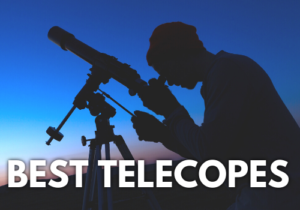
Best Portable Telescope 2025; Reviews
Disclosure: This post contains affiliate links and I may earn a small commission (at no extra cost to you) if you click through and make a purchase. Thanks in advance – I really appreciate it!
Here in this article we’ve rounded up 13 of the best portable telescopes of various types, specifications, and budget. Below, you’ll find in-depth reviews of each, as well as an elaborate buying guide to help you pick out your best portable telescope.
COMPARISON TABLE
| Image | Title | Best For | Features | Price | Buy |
|---|---|---|---|---|---|
Top Top
Top
Top
Top
Top
Top Top
Top
Top
Top
Top
Top | Celestron - 70mm Travel Scope | Best Portable Telescope For Beginners | Type: Reflector Aperture: 70mm (2.8″) Focal length: 400mm Focal Ratio: f/5.7 | See on Amazon | |
 Top
Top
Top
Top
Top
Top
Top
Top
Top
Top | Orion 10149 StarBlast 62mm | Best For Deep Space | Type: Refractor, Aperture: 62mm (2.44″), Focal length: 520mm, Focal Ratio: f/8.4 | See on Amazon | |
 Top
Top
Top
Top
Top
Top
Top
Top
Top
Top | Celestron - NexStar 130SLT | Best GoTo | Type: Newtonian Reflector, Aperture: 130mm (5.12″), Focal length: 650mm, Focal Ratio: f/5 | See on Amazon | |
 Top
Top
Top
Top
Top
Top
Top
Top
Top
Top | Celestron - PowerSeeker 127EQ | Best For Astronomy | Type: Newtonian Reflector, Aperture: 127 mm(5″), Focal length: 1000mm, Focal Ratio: f/8 | See on Amazon | |
 Top
Top
Top
Top
Top
Top
Top
Top
Top
Top | Orion GoScope II 70mm | Best Budget Pick | Type: Newtonian Reflector, Aperture: 70mm(2.75″), Focal length: 400mm, Focal Ratio: f/5.7 | See on Amazon | |
 Top
Top
Top
Top
Top
Top
Top
Top
Top
Top | Orion 10282 STARBLAST 90mm | Best For The Moon | Aperture: 80mm (3.2″), Focal length: 600mm, Focal Ratio: f/7.5 | See on Amazon | |
 Top
Top
Top
Top
Top
Top
Top
Top
Top
Top | Gskyer Telescope, 600x90mm AZ | Best Portable Refractor | Type: Refractor, Aperture: 90mm(3.5”), Focal length: 600mm, Focal Ratio: f/6.7 | See on Amazon | |
 Top
Top
Top
Top
Top
Top
Top
Top
Top
Top | Orion 09007 SpaceProbe 130ST | Best Reflector | Type: Newtonian Reflector, Aperture:130 mm(5.1″), Focal length: 650mm, Focal Ratio: f/5 | See on Amazon | |
 Top
Top
Top
Top
Top
Top
Top
Top
Top
Top | SkyWatcher S11800 GoTo Collapsible Dobsonian 8-Inch | Best Dobsonian | Type: Newtonian Reflector, Aperture: 203mm (8″), Focal length: 1200mm, Focal Ratio: f/5.9 | See on Amazon | |
 Top
Top
Top
Top
Top
Top
Top
Top
Top
Top | Emarth Telescope | Best For kids | Type: Newtonian Reflector, Aperture: 70mm (2.75″), Focal length: 360mm, Focal Ratio: f/5.1 | See on Amazon | |
 Top
Top
Top
Top
Top
Top
Top
Top
Top
Top | Orion 10015 StarBlast 4.5 Astro Reflector | Best Tabletop | Type: Newtonian Reflector, Aperture: 115mm (4.53″), Focal length: 450mm, Focal Ratio: f/4 | See on Amazon | |
 Top
Top
Top
Top | Orion 10013 GoScope | Best Tabletop Reflector | Type: Refractor, Aperture: 80mm (3.14″), Focal length: 350mm | See on Amazon | |
 Top
Top
Top
Top
Top
Top
Top
Top
Top
Top | Celestron - AstroMaster 70AZ | Best Small Pick | Type:Refractor, Aperture: 70mm (2.8″), Focal length: 900mm, Focal Ratio: f/13 | See on Amazon |
Product prices and availability are accurate as of the date/time indicated and are subject to change. Any price and availability information displayed on [relevant Amazon Site(s), as applicable] at the time of purchase will apply to the purchase of this product.
Prices pulled from the Amazon Product Advertising API on: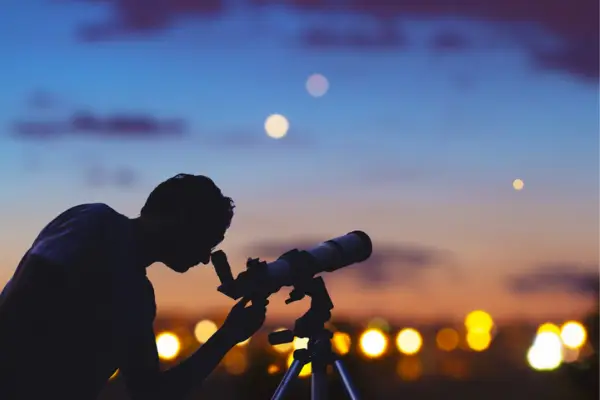
Best Portable Telescope 2024
With so many models with so many features available today, it can be a tedious task to find the best telescope that suits you. We have analyzed the features ( aperture, focal length, ratio, portability etc.) that make the best travel telescope to help you pick out the one that is best for you.
Best For Beginners
Celestron – 70mm Travel Scope
- Type: Reflector
- Aperture: 70mm (2.8″)
- Focal length: 400mm
- Focal Ratio: f/5.7
- Mount: Alt-az
- Eyepiece: 20mm, 10mm
- Magnification: 20x, 40x
- Weight: 4.2 lbs (1.9 kg)
- Our Rating: 9/10
Prices pulled from the Amazon Product Advertising API on:
Product prices and availability are accurate as of the date/time indicated and are subject to change. Any price and availability information displayed on [relevant Amazon Site(s), as applicable] at the time of purchase will apply to the purchase of this product.
This telescope works great considering the fact that it is an inexpensive, portable scope. It provides wide, clear views of the sky that compare with much more expensive models.
The aperture performs surprisingly well given its size, and will most likely suit your needs given that it is a small, portable and one of the best small portable telescope to observe the night sky.
The Travel Scope also comes pre-assembled and ready-to-use, so you can just grab it and go.
Its an easy to use and easy to set up telescope and you don’t have to exert a lot of effort on the installation of this travel scope. Moreover, you don’t even need any tools or equipment to assemble the scope before using it.
The 2.76 inch aperture is well-suited for the purpose of this home telescope and provides bright and crisp views given its size.
All of its optical components are glass coated for an efficient performance. Nevertheless, the light weight tripod is readily adjustable made from pre assembled aluminum and silver finish.
Incorporating a focal length of 400 mm, this device allows you to see clearly the rings of Saturn or the craters of the Moon. It should give you the magnification you need to spot the terrestrial objects you’re looking for in the night sky.
It is compactly built with the 70 mm refractor including two eyepieces used for high and low powered purposes. Nevertheless, the 20 mm eyepiece possesses 20x magnification while the 10 mm eyepiece has 40x magnification.
Also included is Sky X software, which allows you to learn the basics of astronomy and how to use your new telescope. Sky X is a great addition to any telescope and is an excellent tool to help beginners.
It features a smooth functioning altazimuth mount for easy location and shooting over several celestial bodies.
It is also suitable for astrophotography as it comes with a 2.5-degree field of view for greater scope and to enhance the picture quality that will be taken.
The Travel Scope is easy enough for any family member to use at home, it’s also a great telescope for more experienced astronomers will also be able to make great use of its features.
Pros:
- Easy to Use
- Perfect for home use
- Lightweight and highly portable
- Affordable Price
- Excellent optics
- Dual powered eyepieces
- Simple assembly
Cons:
- Shaky tripod
Best For DSOs
Orion StarBlast 62mm
- Aperture: 62mm (2.44″)
- Focal length: 520mm
- Focal Ratio: f/8.4
- Mount: Altazimuth
- Eyepiece: 20mm, 4mm
- Magnification: 26x, 130x
- Weight: 3 lbs.(1.4 kg)
- Our Rating: 9.4/10
Prices pulled from the Amazon Product Advertising API on:
Product prices and availability are accurate as of the date/time indicated and are subject to change. Any price and availability information displayed on [relevant Amazon Site(s), as applicable] at the time of purchase will apply to the purchase of this product.
The highly portable Orion StarBlast APO refractor telescope can be used for almost any type of observing.
During the day, you can insert the included 45° correct-image diagonal into the telescope to make it a perfect deck telescope for scanning the scenic horizon or wildlife. It’s great for catching sharp, detailed views of birds too.
The Orion StarBlast APO travel refractor is one of the best portable telescopes for dso. At night, the advanced 4-element, high resolution, fully multi coated optical design of the StarBlast 62 refractor will let you enjoy great views of the Moon and brighter planets like Jupiter and Saturn.
Its substantial f/8.4 focal ratio provides sharp views of our planet’s celestial neighbors in the night sky.
The telescope features a 2.5-inch, four-element crown and flint glass objective, a focal length of 520mm, along with an extendable dew shield.
The StarBlast 62 comes with two Long Perng “Sterling” Plossl eyepieces, with 20mm and 4mm focal lengths providing 26x and 130x respectively.
The metal lens cap is flock-lined and fits snugly, while plastic dust caps are provided for the drawtube, diagonal and all eyepieces.
Also included are a Crayford focuser, a Vixen-style dovetail mounting block and a high quality aluminum foam-lined case that does a great job protecting the scope and any accessories
The metal lens cap is flock-lined and fits snugly, while plastic dust caps are provided for the drawtube, diagonal and all eyepieces.
Its compact size and a total weight of 3.1 lbs.makes it one of the best travel telescopes for the money.
This 2.5-inch refractor telescope is ideally suited to bright objects such as the Moon, the planets, galaxies and nearby star clusters, but under good and dark conditions it’s also possible to see some fainter deep-sky targets.
The Orion StarBlast uses a long-focus achromatic (non-ED) objective lens in conjunction with a focal reducer/field flattener. The result is that the StarBlast 62 travel refractor has very little chromatic aberration and basically no field curvature, making it extremely sharp at both low and high magnifications as well as being suitable for astrophotography.
This high end instrument is also one of the best travel telescopes for astrophotography as its four-element lens design delivers exceptional contrast and resolution, within a smart-looking tube only 30 centimetres (12-inches) in length (with dew cap retracted).
To facilitate imaging, the package is rounded off with a T-threaded extension tube.
This can be screwed onto a T-ring adaptor to suit a DSLR camera, or into a dedicated astronomy camera.
The focuser is designed to fit standard 1.25-inch eyepieces and accessories, but also has a 42mm external thread, which means a number of other accessories can be attached.
Pros:
- Wide field of view
- Lightweight and portable
- Easy to use
- Compatible with high-quality accessories
- Suitable for astrophotography
- Perfect for beginners and families with children
- Comes with a high end foam-lined travel case
Cons:
- No finderscope
- Doesn’t come with a tripod
Related
Best Portable GoTo Telescope
Celestron – NexStar 130SLT
- Type: Newtonian Reflector
- Aperture: 130mm (5.12″)
- Focal length: 650mm
- Focal Ratio: f/5
- Mount: Computerized Alt-az
- Eyepiece: 25mm, 9mm
- Magnification: 26x, 72x
- Weight: 18.0 lbs.(8.2 kg)
- Our Rating: 9.4/10
Prices pulled from the Amazon Product Advertising API on:
Product prices and availability are accurate as of the date/time indicated and are subject to change. Any price and availability information displayed on [relevant Amazon Site(s), as applicable] at the time of purchase will apply to the purchase of this product.
The NexStar 130SLT is a unique reflector telescope from Celestron. The reflector technology uses mirrors to obtain the maximum amount of light possible and therefore to produce images of remarkable clarity, even when located deep in space.
It’s a 130mm f/5 Reflector Telescope which is a complete platform for making observations of the Moon, planets, and bright deep-space objects such as binary stars, star clusters, galaxies and nebulae.
With a focal length of 650mm, this model is an f/5 scope. F/5 scopes are fairly fast, meaning that you have a wide field of view, which is useful for short exposure astrophotography of big portions of the sky.
The Celestron NexStar 130 SLT Computerized Telescope removes the issue of struggling to find a planet or star using a paper star map.
With the Celestron NexStar 130 SLT Computerized Telescope comes a handheld computer that features SkyAlign technology incorporated right into the telescope, automatically finding and pointing the telescope to the planet or star that you would like to see by way of a few button presses.
This is an ideal telescope if you plan to travel or do some outdoor stargazing.
This telescope comes with a pre-assembled, adjustable stainless-steel tripod, quick release fork arm, NexStar+ computerized hand control, 130mm Newtonian Reflector optical tube, and lots of amazing accessories.
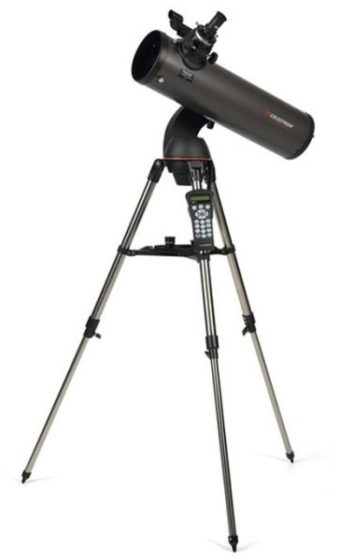
The Celestron NexStar 130SLT is designed to maximize celestial views. The scope does so by using its reflector method to bring about clear views of details such as the Hercules globular cluster, stars, or the Great Orion Nebula. These views are made possible by the telescope’s ability to use mirrors to collect and distribute the light that creates the detailed views of far away objects.
The computerized hand control of this SLT telescope gives you the ability to automatically slew to any of its 40,000+ objects, including over 600 galaxies, 300 clusters, stars and planets.
For astrophotography since The NexStar SLT telescopes use Alt-Az mounts, you will be limited to short exposure photographs.
With the high aperture of the NexStar 130 SLT, Deep Sky Observation with medium-length exposure times are certainly possible.
For example, you will be able to get some great shots of the Moon (closeups and wide shots), while also being able to photograph some nebulae and other deep sky formations and objects. The reason for this is that Newtonians like NexStar 130 SLT have a fairly wide field of view.
Pros:
- Wide field of view
- Handheld computer makes it easy to find celestial bodies
- Weighs only 18 pounds for simple transport
- Deep views of the sky
Cons:
- The motor uses up batteries fairly quickly
- The date and time must be set after each use
Best For Astronomy
Celestron – PowerSeeker 127EQ
- Type: Reflector
- Aperture: 127 mm(5″)
- Focal length: 1000mm
- Focal Ratio: f/8
- Mount: German Equatorial
- Eyepiece: 20mm, 4mm
- Magnification: 50x, 250x
- Weight: 22.0 lbs.(10.0 kg)
- Our Rating: 9/10
Prices pulled from the Amazon Product Advertising API on:
Product prices and availability are accurate as of the date/time indicated and are subject to change. Any price and availability information displayed on [relevant Amazon Site(s), as applicable] at the time of purchase will apply to the purchase of this product.
The Celestron PowerSeeker 127EQ telescope is a Newtonian reflector, which means it uses mirrors to gather the light of the skies, and reflects it for viewing. With mirrors being much less expensive to produce than glass lenses, reflector telescopes offer more value in terms of inches of aperture.
The PowerSeeker 127EQ comes with two eyepieces (4mm and 20mm) and a 3x Barlow lens.
The 5-inch mirror on the 127mm PowerSeeker model limits useful magnification to about 250x, which is achieved using the 4mm eyepiece.
The larger 20mm eyepiece provides a more useful 50x magnification. This grows to 150x when coupled with the 3x Barlow.
If you’re considering an additional eyepiece, something like a 15mm Plossi would be a good option. This provides you with 66x magnification, or 198 when coupled with the Barlow.
The telescope is ideal for near and deep-sky observation, Celestron’s PowerSeeker 127EQ 127mm f/8 Reflector Telescope features a respectable focal length and a large, parabolic mirror that produce detailed images of the Moon, clear views of the planets, and the ability to resolve bright distant objects such as nebulae and galaxies.
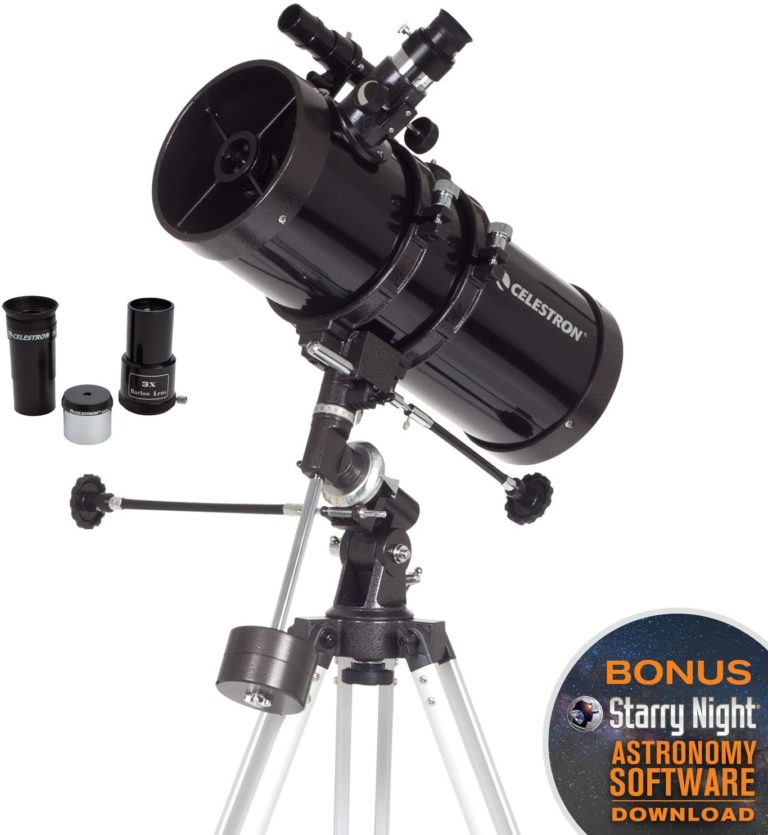
The beauty of a Newtonian telescope is the longer focal lengths which can be offered in much shorter tube sizes—1000mm focal length in a tube which is only 20 inches (508mm) long .
The PowerSeeker 127EQ is highly portable and one of the best travel telescopes under $500. You could easily fit this telescope and tripod in the trunk of a car and still have room for your other equipment, or maybe a late night picnic.
Additionally, you receive a copy of Starry Night astronomy software with a database of over 10,000 celestial objects.
Considering the telescope’s low price, compromises had to be made, and one such compromise is the use of a spherical mirror rather than a parabolic mirror.
Optical aberrations tend to be more common with spherical mirrors. This telescope does, however, feature an erect image diagonal for the right way up images, which prevents some aberration.
This telescope comes with an Equatorial mount, designed for astronomy telescopes. Included are two manual slow-motion controls, these allow for smoother tracking of objects as they pass across the night sky.
The tripod is made of aluminum, although lightweight, it is robust, solid and also comes with a very handy accessory tray which lets you keep extra eyepieces and T-rings for a camera, close to hand.
Pros:
- Solid build quality
- Stable mount
- Comes with a 3x Barlow lens
Cons:
- Spherical mirror leads to some amount of aberrations
- Occasional collimation of the mirrors required
Best Budget Telescope
Orion 10034 GoScope II
- Type: Newtonian Reflector
- Aperture: 70mm(2.75″)
- Focal length: 400mm
- Focal Ratio: f/5.7
- Mount: Altazimuth
- Eyepiece: 25mm, 10mm
- Magnification: 16x, 40x
- Weight: 3.5 lb / 1.6 kg
- Our Rating: 8.6/10
Prices pulled from the Amazon Product Advertising API on:
Product prices and availability are accurate as of the date/time indicated and are subject to change. Any price and availability information displayed on [relevant Amazon Site(s), as applicable] at the time of purchase will apply to the purchase of this product.
The Orion 10034 GoScope II 70mm Refractor Travel Telescope Moon Kit is a specifically designed telescope for advanced moon viewings from one of the best telescope brands in the world.
The affordable Orion GoScope II 70mm Refractor Travel Telescope features a 70mm achromatic lens system for sharp images of distant subjects.
This provides high quality, crisp and sharp images of distant objects. The resulting images are far better than other telescopes in this price range.
This 400mm focal length telescope (f/5.7) is perfect for daytime birding use as well as viewing wildlife, scenery and nighttime observing of the Moon and bright planets with the entire family.
The telescope includes 5×24 finder scope and two 1.25″ telescope eyepieces (25mm and 10mm) for 16x and 40x magnification.
It also comes with the Orion MoonMap 260 which helps you and your family learn more about the Moon and it’s surface.
Its light weight of just 3.5 lbs. makes it easy for kids and beginners to take the telescope anywhere.
The telescope and its aluminum tripod can be easily stored and carried to your favorite observing location in it’s included backpack.
The Orion 10034 GoScope Refractor Travel Telescope is one of the best budget travel telescopes in regards to value for money, and is a great tool for travelling and outdoors activities. It’s light, easy to use and doesn’t require extensive knowledge of either telescopes or astronomy.
You will find a lot of uses for the respectable optics of the Orion GoScope II 70mm Refractor Travel Telescope, and a lot of times and places to use them, day or night.
Pros:
- Lightweight aluminum tripod for beginners and families on the go
- Rugged and robust, hence will last you a long time
- Good value for money
- Decent optics for the price
Cons:
- Does Not come with instruction manual
- Not suitable for professional use
Best For The Moon
Orion 10282 STARBLAST
- Aperture: 80mm (3.2″)
- Focal length: 600mm
- Focal Ratio: f/7.5
- Mount: Computerized Alt-az
- Eyepiece: 20 mm, 5 mm
- Weight: 22 lbs.(10 kg)
- Our Rating: 9.4/10
Prices pulled from the Amazon Product Advertising API on:
Product prices and availability are accurate as of the date/time indicated and are subject to change. Any price and availability information displayed on [relevant Amazon Site(s), as applicable] at the time of purchase will apply to the purchase of this product.
This is a 90mm Refractor telescope which is surprisingly capable and highly portable. It is a quality 90mm achromatic refractor telescope outfitted with a full-length stainless steel tripod and two-way pan head as well as some great accessories — all of which fit neatly into a rugged carry case with both shoulder and hand straps for convenient transport and storage.
The StarBlast 90mm Altazimuth Travel Refractor Telescope features an antireflection coated 90mm achromatic lens system with a 500mm focal length (f/5.6) for vivid images of distant subjects.
The 1.25″ rack-and-pinion focuser ensures your observing target will snap into sharp focus effortlessly.
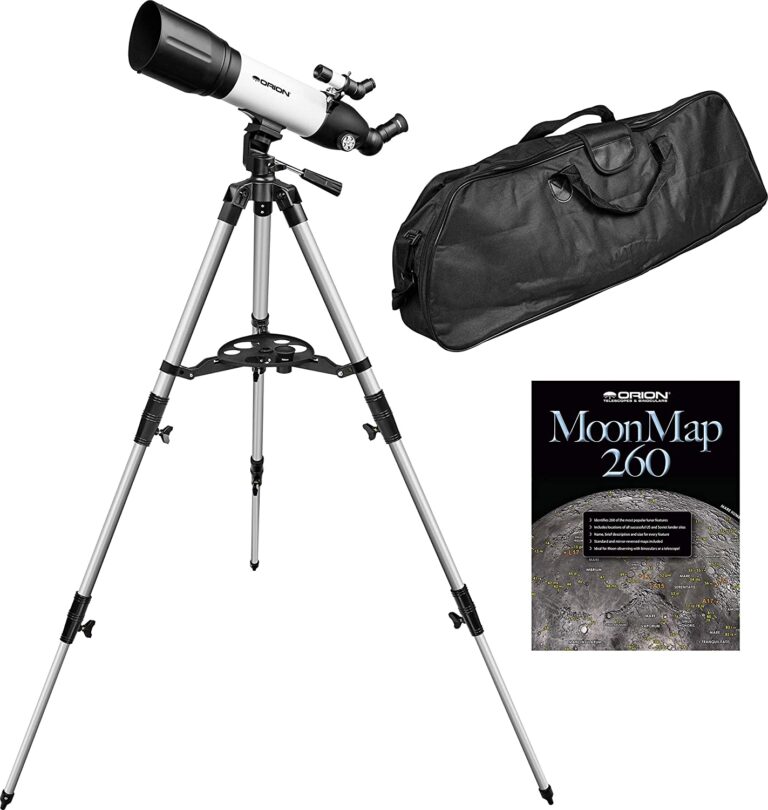
The integrated, rotatable 45-degree correct-image diagonal allows daytime views of terrestrial subjects in their proper orientation, unlike refractors that come with a “star diagonal,” which show a mirror-reversed image and are better suited for astronomical observation only.
The 5×20 correct-image finder scope provides matching views in a wider field, to make spotting your targets a snap.
And for stargazing, this telescope will reveal outstanding views of the Moon’s surface, Saturn’s rings, and scores of deep-sky nebulae and star clusters.
The super sturdy, extendable tripod is made of stainless steel and has a center brace for added rigidity.
A convenient accessory tray fastens onto the center brace with a simple twist-lock mechanism. The two-axis pan head provides easy, smooth control of the telescope via the pan handle.
Pros:
- Highly portable
- Affordable
- Includes a Moon map
- Great optics
- Comes with a carry bag
Cons:
- Not for deep space objects
Best Portable Refractor
Gskyer Telescope AZ90600
- Type: Refractor
- Aperture: 90mm(3.5”)
- Focal length: 600mm
- Focal Ratio: f/6.7
- Mount: Altazimuth Mount
- Eyepiece: 25mm,10mm,5mm
- Magnification: 24x, 60x, 120x
- Weight: 18 lbs. / 8.2 kg
- Our Rating: 9.2/10
Prices pulled from the Amazon Product Advertising API on:
Product prices and availability are accurate as of the date/time indicated and are subject to change. Any price and availability information displayed on [relevant Amazon Site(s), as applicable] at the time of purchase will apply to the purchase of this product.
Gskyer is a German company and is one of the best telescope brands in the world, known to produce high-quality telescopes.
This is a great starter telescope for the explorer who intends to take their telescope with them on their journeys. Hiking, camping, and even moonlit fishing trips will be more fun when you have this telescope along with you.
The Gskyer AZ90600 is one of the best refractor telescopes for the money. If you live in the city and you aren’t able to see much of the sky due to light pollution, you’ll want a telescope like this that’s easy to carry with you.
The 90 millimeter aperture is perfect for viewing most of the things you’d want to view, and all of the glass optics are coated to automatically adjust the brightness of the stars to a level safe and comfortable for observation.
Though this is a beginner telescope, you can use it to observe the moon, stars, meteors, and planets. The telescope offers great clarity, allowing you to see the surface of the moon, the rings of Saturn and the moons of Jupiter.
It also comes with a smartphone adapter, which allows you to use the phone as a screen, or as a camera to take great pictures.
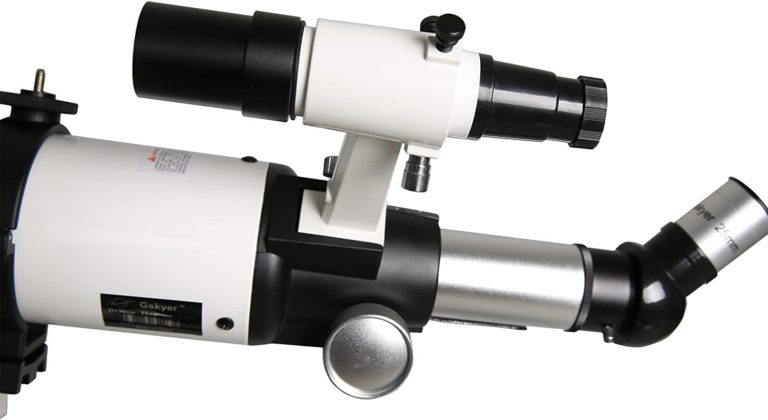
Plus, this model is extremely easy to assemble and doesn’t require any calibration. If you’re a telescope beginner, you won’t have to worry about any tricky steps or complicated tests.
The Gskyer AZ90600 comes with an adjustable tripod. This adjustable aluminium tripod offers the viewer many different viewing positions. The height of the aluminum tripod can be adjusted from about 31.5-inch to 49-inch.
This is one of the best intermediate refractor telescopes, it’s 90mm (3.5″) aperture gives bright, sharp images for both land and celestial objects.
Whether you’re viewing the rings of Saturn, the moons of Jupiter, surface details on the Moon, or terrestrial objects, the Infinity 90 Refractor allows the amateur astronomer to explore the solar system and beyond.
Pros:
- Large aperture
- 3 eyepieces
- Smartphone adapter
- Easy to assemble and use
- Adjustable tripod
- Perfect travel telescope
Cons:
- Good for viewing planets, stars not so much
Best Reflector Telescope
Orion 09007 SpaceProbe 130ST
- Type: Reflector
- Aperture: 130 mm(5.1″)
- Focal length: 650mm
- Focal Ratio: f/5
- Mount: Equatorial
- Eyepiece: 25mm, 10mm
- Magnification: 26x, 65x
- Weight: 24.2 lbs.(11 kg)
- Our Rating: 9/10
Prices pulled from the Amazon Product Advertising API on:
Product prices and availability are accurate as of the date/time indicated and are subject to change. Any price and availability information displayed on [relevant Amazon Site(s), as applicable] at the time of purchase will apply to the purchase of this product.
The Orion SpaceProbe 130ST Newtonian Reflector is an excellent and one of the best telescopes under $500. It is well-suited for both beginners as well as intermediate stargazers.
The SpaceProbe’s 5.1″ parabolic primary mirror is a good size for a beginner’s telescope. Its primary mirror allows great views of the planets and moon, and its wide field of view is great for bright nebulae, galaxies and star clusters.
The SpaceProbe 130ST is a 130mm f/5 Newtonian reflector telescope.
This 5.1″ aperture reflector telescope gathers an ample amount of light for great views of the planets and Moon, as well as brighter galaxies, nebulas, and star clusters
The telescope also comes with tools to help you assemble the product, and two eyepieces: 10mm for 65x, and a 25mm for 26x magnification, respectively.
The quick set-up and ease of use makes the SpaceProbe 130ST EQ a very versatile telescope which the whole family can enjoy.
This Orion space probe telescope also boasts a short 24″ long optical tube design which enhances its portability, while the 130mm optical diameter, and the 650mm focal length are in perfect balance with the f/5.0 focal ratio.
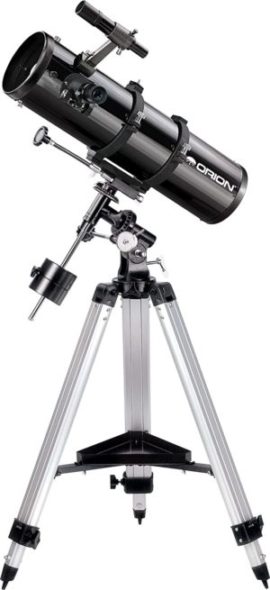
The Orion SpaceProbe 130ST offers you enjoyable views of more than just the moon and planets.
Its 5.1 inch aperture possesses light gathering abilities designed to garner views that will satisfy the curiosity of almost any beginning star gazer. These views include everything from the moon to galaxies to nebulae and more.
In addition, it possesses design features, such as a parabolic mirror and a specially designed holder for the secondary mirror, that focus the light captured by the aperture and use it to sharpen the images produced by the scope, even with its shorter tube.
The included aluminium tripod is very sturdy, and also includes an accessory tray that can be very useful when you are outdoors in the dark and need a place to organize your accessories neatly.
The equatorial mount is perfectly built and allows manual slow-motion tracking of celestial objects as they move across the sky.
The mount can also be upgraded at a later time to a motorized option that tracks objects automatically, so that’s a nice option to have and definitely a plus if you are using the Orion SpaceProbe 130ST for astrophotography.
Just like many other similar products, the Orion 09007 also comes with Orion’s Starry Night software, which is very useful for beginners, and has the added benefit of alerting the user of upcoming celestial events.
Short 24″ long optical tube design for easy portability and fast f/5 focal ratio for pleasing wide-field performance makes the SpaceProbe 130ST EQ a very versatile telescope the whole family can enjoy
Pros:
- Nice set of accessories
- Can be upgraded to have motorized tracking
- Comes with an Equatorial mount and a versatile tripod
- Easy to assemble and transport
Cons:
- Plastic focuser and mount parts
Best Portable Dobsonian
SkyWatcher S11800
- Type: Newtonian Reflector
- Aperture: 203mm (8″)
- Focal length: 1200mm
- Focal Ratio: f/5.9
- Mount: Computerized – GoTo Dobsonian
- Eyepiece: 25mm,10mm
- Weight: 57.2 lbs.(26.0 kg)
- Our Rating: 9.8/10
- Max focal length: 1200
Prices pulled from the Amazon Product Advertising API on:
Product prices and availability are accurate as of the date/time indicated and are subject to change. Any price and availability information displayed on [relevant Amazon Site(s), as applicable] at the time of purchase will apply to the purchase of this product.
The USP of the SkyWatcher S11800 GoTo Collapsible Dobsonian is that it is amazingly portable.
This collapsible telescope features a patented truss tube system that enables the front corrector plate/eyepiece assembly to be moved back and locked against the main rear tube to reduce the size for storage and transportation.
Thanks to its collapsible truss tube, the scope becomes small enough to fit in most hatchbacks or on a back seat. It is truly portable, and once assembled, can be set up and ready to use in minutes.
The included SynScan computerized hand control is the brain behind the Sky-Watcher GoTo Dobsonian.
It allows you to point your telescope at a specific object, or even tour the night sky at the touch of a button!
With an internal database of more than 42,000 celestial objects, this easy-to-use hand control can locate any object you see in the night sky with push-button ease.
You can even let your Sky-Watcher GoTo Dobsonian take you on a tour of all the best objects based on your time and location.
In order to increase the light-gathering factor of this no-fuss scope’s mirror-based optical system, the two mirrors are coated with a layer of hard quartz and an additional layer of titanium dioxide.
The Sky-Watcher Dobsonian SynScan telescope has a patented dual encoder design incorporated to record the position of the telescope.
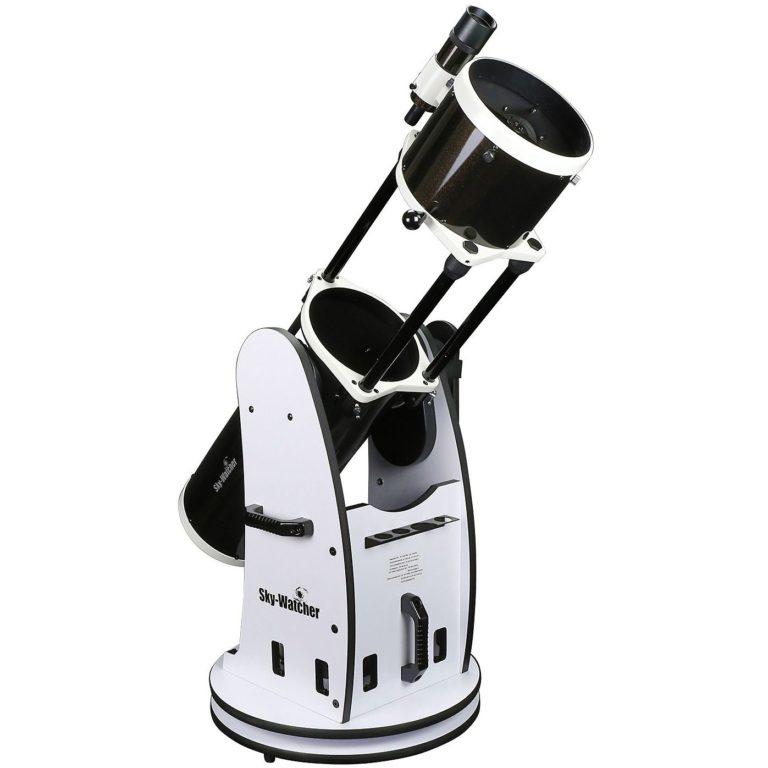
Under the Auto-Tracking Mode, you may choose to move the telescope, either manually or electronically, to any position without deactivating the tracking mode.
The AZ GoTo mode provides extensive computerized GoTo functions to assist you in finding and enjoying numerous celestial and deep space objects.
The 8-Inch Sky-Watcher Dobsonian SynScan is precision engineered telescope that will allow you to easily find and enjoy night sky treasures like Saturn, Jupiter, and other planets in the solar system, plug a huge array of deep-sky objects including galaxies, star clusters, nebulae, and more.
This Dobsonian was carefully engineered to combine ease of use, extreme portability and consistent performance in an affordable package.
No doubt, there are other truss tube designs, but the Sky-Watcher Collapsible Dobsonian does not need to be disassembled between uses.
It transports as two compact pieces that can be assembled, collimated easily and ready to use in just seconds.
Pros:
- Collapsible tube design for extreme portability
- Easy to setup and use
- Wide 8’ aperture and wide field view
- Best for dso, planets, galaxies and more
- Perfect for all-level users
Cons:
- Expensive
- No collimation tool provided
Best For kids
Emarth Telescope
- Type: Newtonian Reflector
- Aperture: 70mm (2.75″)
- Focal length: 360mm
- Focal Ratio: f/5.1
- Mount: Altazimuth
- Eyepiece: 25mm, 10mm
- Barlow Lens: 3x
- Magnification: 51x, 128x
- Weight: 2.87 lbs. (1.3 kg)
- Our Rating: 8.4/10
Prices pulled from the Amazon Product Advertising API on:
Product prices and availability are accurate as of the date/time indicated and are subject to change. Any price and availability information displayed on [relevant Amazon Site(s), as applicable] at the time of purchase will apply to the purchase of this product.
The Emarth travel telescope is one of the best telescopes for the kids.
It’s equipped with a lens that has 360mm focal length and 70mm aperture. It comes with coated glass to make moon watching the best experience for the user.
It’s super easy to use and can be an excellent educational and fun gift for your child. If your child enjoys watching and exploring stars, then he or she will surely enjoy it’s 5×24 finder scope.
This model is very easy to assemble, and shouldn’t take more than a few minutes to set up.
It also comes with two eyepieces, a 10mm and a 25mm, which are slightly better than most eyepieces included at this price point.
It uses a BAK-4 prism for better viewing and it comes along with a solar system map.
The Travel Scope provides clean, crisp views. Developed with the traveler in mind,this travel scope features a compact and portable design perfect for the on-the-go stargazer.
Pros:
- Compact and lightweight, easy to carry
- Comes with its own carry case
- Easy to setup and use
- Perfect for kids
Cons:
- Small tripod
Best Tabletop Reflector
Orion StarBlast Tabletop Reflector
- Type: Newtonian Reflector
- Aperture: 115mm (4.53″)
- Focal length: 450mm
- Focal Ratio: f/4
- Mount: Altazimuth
- Eyepiece: 17mm, 6mm
- Magnification: 26x, 75x
- Weight: 13 lbs(5.9 kg)
- Our Rating: 9/10
Prices pulled from the Amazon Product Advertising API on:
Product prices and availability are accurate as of the date/time indicated and are subject to change. Any price and availability information displayed on [relevant Amazon Site(s), as applicable] at the time of purchase will apply to the purchase of this product.
The Orion StarBlast 4.5 (10015) is an excellent choice of telescope for beginners who are eager to begin their astronomical careers, as well as for intermediate astronomers looking for a budget travel telescope, who can utilize its features for the best extraterrestrial viewing.
You don’t have to spend time assembling the Orion 10015 StarBlast 4.5 Astro Reflector, as the telescope arrives pre-built so that anyone can take it out of the box and begin using it right away. It’s a great compact and highly portable budget telescope for beginners and families.
The scope features a substantial 4.5″ aperture and f/4 focal ratio that provides bright, detailed views of solar system targets like the Moon and planets, as well as wide-field celestial objects like nebulas and star clusters.
The telescope’s lens is made of a low thermal expansion borosilicate glass. This means that it is capable of focusing light with increased precision.
The StarBlast’s included red-dot finder is more than adequate, thanks to its extremely wide field of view.
The model only comes with a tabletop mount, so it really can only be used indoors or outdoors on a picnic table or similar piece of patio furniture.
Its table top design makes it one of the best travel telescopes for the money. It has a wider footprint than some competing models, which makes it more steady and less prone to being knocked over.
On clear nights, you will be able to view not only the Moon and its craters, but also Jupiter, Saturn, and its beautiful rings.
The scope’s Dobsonian mount means that beginners and new users can point easily. All in all, the Orion Starblast 4.5 will enchant even advanced users with its bright images of the galaxies, nebulas, and star clusters.
Pros:
- Simple to use
- Equipped with EZ Finder for easy aiming
- Includes Starry Night astronomy software
- Features a fast-focal ratio
- Comes pre-assembled
- Two eyepieces along with a dust cover in this telescope
Cons:
- Cannot attach DSLRs
- Collimation process takes a lot of time
Best Portable Tabletop Refractor
Orion 10013 GoScope
- Aperture: 80mm (3.14″)
- Focal length: 350mm
- Focal Ratio: f/4.3
- Mount: Altazimuth
- Eyepiece: 20mm,10mm
- Magnification: 17x, 35x
- Weight: 5.7 lbs.(2.6 kg)
- Our Rating: 9.6/10
Prices pulled from the Amazon Product Advertising API on:
Product prices and availability are accurate as of the date/time indicated and are subject to change. Any price and availability information displayed on [relevant Amazon Site(s), as applicable] at the time of purchase will apply to the purchase of this product.
The Orion GoScope 80mm Tabletop Refractor Telescope, is a rare telescope model that has the advantage of being both incredibly portable, as well as extremely easy for a beginner to use.
This ultra-compact, entry-level refractor with a tabletop mount makes a great, high-quality first telescope for children and beginners.
Although it may look like the telescope for kids, it’s not just for newbies – the GoScope 80mm TableTop Refractor’s convenient small size makes it a true “grab-and-go” telescope, perfect for on the move experienced stargazers.
The telescope comes complete with 10 mm and 20 mm eyepieces, and can magnify objects in the night sky by up to 165 times their size. An EZ finder is included that allows novice astronomers to locate objects in the night sky, and follow their movements with ease.
The entire telescope weighs just 5.65 lbs. assembled (including eyepiece and reflex sight) so it’s easy for anyone in the family to take it out to the backyard table or an observing site.
The Orion GoScope 80mm Tabletop Refractor has an 80-mm aperture that captures a large amount of light to give you the benefit of very bright images. The brightness gives the telescope the ability to target distant objects in the deep sky, so that you can see things like the Orion Nebula that smaller telescopes would likely miss.
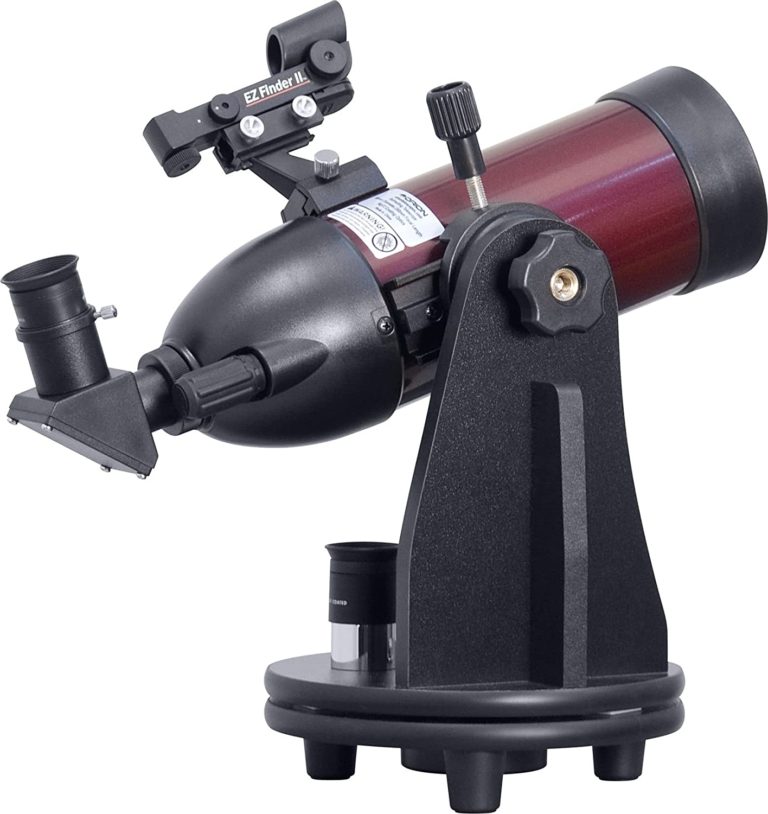
Being light (around 9 pounds), compact and easy to travel with, the Orion 10013 GoScope 80mm TableTop Refractor Telescope will definitely become your best pal in trips or while camping with the family. If you want any extra height, you can place it on a regular tripod as the Go Scope has a special insert on the bottom.
The optical tube assembly of the GoScope 80mm Refractor Telescope is attached to its sturdy table-top swivel base with a quick-release dovetail saddle which features adjustable altitude tension. This allows you to set the up/down tension of the mount according to your preference, for smooth motion.
The GoScope travel telescope tube can easily be removed from the base and mounted on an optional photo tripod, utilizing threaded holes on the optical tube mounting block.
Alternatively, the GoScope’s swivel base itself can also be mounted on a camera tripod to raise the telescope if you cannot find a convenient flat surface nearby.
Pros:
- Surprisingly good optics
- Great for beginners and children
- Easy to use and travel with
- Can be easily attached to a mount
- Produces extremely bright images
Cons:
- Not good for astrophotography
- Not for professionals
Best Small Telescope
Celestron – AstroMaster 70AZ
- Type:Refractor
- Aperture: 70mm (2.8″)
- Focal length: 900mm
- Focal Ratio: f/13
- Mount: Alt-Azimuth
- Eyepiece: 20mm,10mm
- Magnification: 45x, 90x
- Weight: 11.0 lbs (5.0 kg)
- Our Rating: 9.2/10
Prices pulled from the Amazon Product Advertising API on:
Product prices and availability are accurate as of the date/time indicated and are subject to change. Any price and availability information displayed on [relevant Amazon Site(s), as applicable] at the time of purchase will apply to the purchase of this product.
With 70mm aperture and mounted on an altazimuth mount. It’s an entry level telescope that has several nice features that make it a great option for the beginner astronomer.
The AstroMaster 70 is a 70mm f/12 achromatic refractor, using a standard Fraunhofer configuration with crown and flint glasses for the objective lens. The long focal ratio means that there is not much chromatic aberration (false color).
Its medium aperture and long focal length allow it to draw in a generous amount of light with a high magnification potential to allow observation of the larger planets and the moon.
The included 90° diagonal has an integrated erecting prism that corrects the view to enable the scope’s use on land. Celestron includes two eyepieces for high and medium magnifications.
The Astromaster 70 AZ comes with two eyepieces (20 mm and 10 mm respectively) and a StarPointer Finderscope.
One of the best features of the Celestron 21061 AstroMaster 70 AZ Telescope is that the StarPointer is permanently fixed right next to the eyepiece. Moreover, it uses the red dot technology for lining up a celestial object, a feature you can find on more advanced and expensive telescopes.
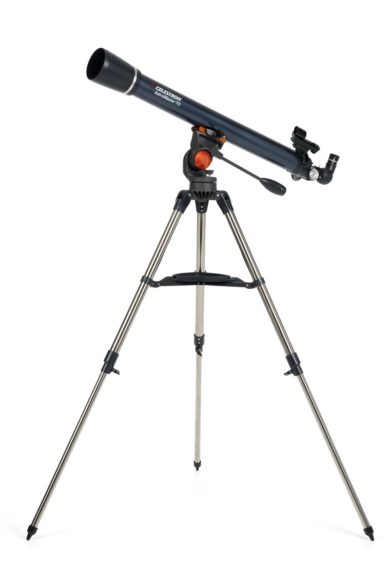
The AstroMaster 70 has a 1.25” rack and pinion focuser which is mostly plastic. It works well.
The red-dot finder is attached to the left side of the focuser and is more than adequate for a small scope such as a 70mm refractor.
The telescope makes it possible to view the moon, stars, planets and nebulae, and on very clear nights, it can even allow a user to catch sight of the moons of Jupiter and the rings of Saturn.
The telescope has multi-coated optics that minimize the breakdown of light as it passes through the telescope, ensuring that images are bright and clear.
The AstroMaster is outfitted with a manual alt-azimuth mount and to make finding and tracking objects easy, there is an altitude control handle and an azimuth lock. Supporting the mount and optical tube is a stainless-steel tripod with sturdy 1.25″ diameter legs.
The scope can magnify objects by up to 165 times their size, and has a convenient accessory tray.
With the telescope, you receive access to a database that includes 10,000 celestial objects.
This allows children to learn more about what they’re seeing in the night sky, and to find out what objects to look for during stargazing sessions on any particular night of the year.
Pros:
- Great value for money
- Comes with fully coated professional lenses
- Can also be used for terrestrial viewing
- Perfect for beginners and kids
- Requires no tool to setup
- Easy to use
Cons:
- Sensitive to heat
- Mount is small, a bit short for an average adult
Best Portable Telescope - Buying Guide
Telescopes are an incredible door to the heavens, for anybody intrigued by space and astronomy.
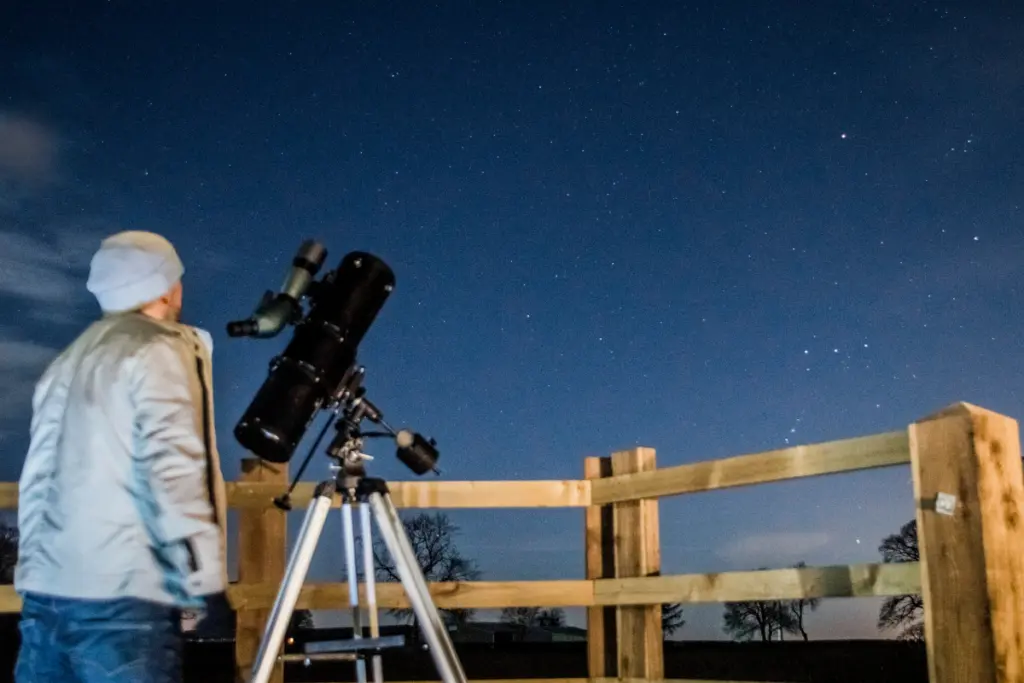
Features To Consider When Buying A Portable Telescope
Aperture
The aperture of a telescope refers to the diameter of either the objective lens of a refractor or objective mirror of a reflector.
The aperture size is the true key to the “power” of a telescope—its size is directly proportional to the scope’s ability to gather light. And the more light a scope can gather, the better the image an observer will see.
However, that doesn’t mean you should simply buy the telescope with the largest aperture you can find. If your scope is inconveniently large, you are less likely to use it, let alone travel with it.
Typically, 2.4-inch (60-millimeter) and 3.1-inch (80-millimeter) refractors and 4.5-inch (114-millimeter) and 6-inch (152-millimeter) and 8-inch reflectors are popular for amateurs.
All the telescopes in our list above are 8-inches and below.
Focal Ratio
This is the ‘speed’ of a telescope’s optics, found by dividing the focal length by the aperture. The smaller the f/number, the lower the magnification, the wider the field, and the brighter the image with any given eyepiece or camera.
Fast f/4 to f/5 focal ratios are generally best for lower power wide field observing and deep space photography. Slow f/11 to f/15 focal ratios are usually better suited to higher power lunar, planetary, and binary star observing and high power photography. Medium f/6 to f/10 focal ratios work well with either.
Focal Length
Focal length refers to the distance between the primary lens/mirror and the point where the object is brought into focus.
The focal length is important, because it’s a factor in how well a telescope magnifies objects. To figure out the magnification, divide the focal length of the telescope by the focal length of the eyepiece: If you have a 25-millimeter eyepiece and a refractor of 1000 mm, the magnification is 40 power, written as 40x (or, 1000 / 25 = 40).
To avoid fuzziness, make sure to magnify a telescope to no more than twice the aperture of your telescope in millimeters (or 50 times the aperture in inches).
Mount
The Mount is what the OTA is attached to and is responsible for the how the user aligns, moves, and tracks celestial objects.
There are three principal types of mounts: Alt-Azimuth (AZ or Alt-Az), German Equatorial (EQ), and Motorized. Motorized mounts can be of either Alt-Az or EQ, but are usually set aside to differentiate them from manual mounts.
An altazimuth mount can be moved up and down and side to side, and usually requires you to make manual corrections when you’re watching an object move across the sky.
A better option can be an equatorial mount, with one axis aligned parallel to the Earth’s axis of rotation. If you live in the Northern Hemisphere, you orient an equatorial by pointing at the North Star, Polaris.
More sophisticated users may want computerized or GoTo mounts, which can automatically move in the right direction to track objects in the sky.
Usually, you need to input the date, time and location of your session before starting. Some systems require you to point the telescope at two or three bright objects in order to calibrate it.
Eyepieces
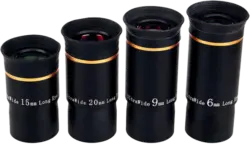
Any new telescope should have at least one eyepiece, and some sets come with two or three. An eyepiece is rated by millimeters, with smaller numbers indicating higher magnification. A 25-millimeter eyepiece is common and appropriate for most stargazers.
It’s important to remember that while a higher-magnification eyepiece may provide more details, it can be harder to keep an object in view.
To get the steadiest seeing in such cases, you may need to use a motorized mount. A lower-power eyepiece makes it easier to find objects and keep them in view. It will also require less light, so viewing dimmer objects is easier.
High- and low-power eyepieces each have their place in observing, so their value depends on the interests of the stargazer.
Types Of Telescopes
While telescopes come in many different forms, there are three general types to choose from.
There are refractors, which collect light with lenses; reflectors, which use mirrors; and compound telescopes, which are hybrids of the two.
Refractors feature a lens at the front of the telescope’s tube. They don’t require much effort to maintain, but they get expensive as the size of the lens gets bigger. There are two main types of refractors: apochromatic and achromats. You should use apochromats because they offer better optical quality, even though they are more expensive, Sky & Telescope said.
Reflectors are a more affordable option than refractors, but they require more maintenance, because their optics can fall out of alignment. To gather light, reflectors use a curved mirror at the back end of the telescope’s main tube.
Compound telescopes use both lenses and mirrors to gather light, and they’re quite portable, because their tubes are more compact and lighter. The most popular designs are Schmidt-Cassegrains and Maksutov-Cassegrains.
Conclusion
We highly recommend Orion 6 Inch Newtonian Astrograph Reflector Telescope if you are looking for a portable telescope to take pictures of night sky and memorialize your experience.
It is the best portable astrophotography telescope on our list. The scope features a fast 6″-aperture and 94% reflectivity coatings which will help you acquire outstanding high-resolution images of deep-sky objects.
The Celestron – 70mm Travel Scope is our top pick for beginners who are looking to buy their first travel telescope.
The Celestron Travel Scope 70mm f/5.7 AZ Refractor Telescope Kit is designed for portability and ease of use for both astronomical and terrestrial use.
Its refractor-style optical tube assembly (OTA) has a respectable aperture that gathers copious amounts of light, and a shorter focal length that produces a moderate magnification potential.
The Orion 10149 StarBlast Travel Telescope is our top pick for the best portable telescope for deep space objects. This beautifully constructed travel refractor telescope is perfect for the on-the-go astronomers.
The 4-element lens system provides sharp, detailed views of the Moon, planets, and bright deep space objects as well as birds, wildlife and other daytime targets. Additionally, it also comes with its deluxe foam-lined hard carrying case.
ABOUT US
We are a team of active amateur astronomers, here to help you with all your astronomy and science related needs – this is anything, from reviewing the latest telescopes to be released to talking about gravity and neurons. The Big Bang Optics was started because of our love for astronomy and to help others like us find the best telescope and accessories.
LEGAL DISCLAIMER
The Big Bang Optics is a participant in the Amazon Services LLC Associates Program, an affiliate advertising program designed to provide a means for sites to earn advertising fees by advertising and linking to Amazon.com. The Big Bang Optics also participates in affiliate programs with Clickbank and other sites. The Big Bang Optics is compensated for referring traffic and business to these companies.



